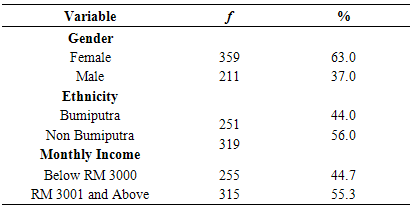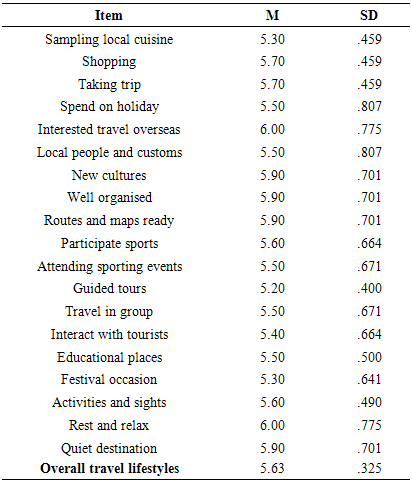-
Paper Information
- Previous Paper
- Paper Submission
-
Journal Information
- About This Journal
- Editorial Board
- Current Issue
- Archive
- Author Guidelines
- Contact Us
American Journal of Tourism Management
p-ISSN: 2326-0637 e-ISSN: 2326-0645
2015; 4(2): 40-42
doi:10.5923/j.tourism.20150402.03
Travel Lifestyles and Outbound Tourism Intentions of Young Malaysians
Cheah Swee Ting, Lim Khong Chiu, Kalsom Kayat
School of Tourism, Hospitality and Environmental Management, Universiti Utara Malaysia, Malaysia
Correspondence to: Cheah Swee Ting, School of Tourism, Hospitality and Environmental Management, Universiti Utara Malaysia, Malaysia.
| Email: |  |
Copyright © 2015 Scientific & Academic Publishing. All Rights Reserved.
The young travellers’ segment is an emerging market for today’s travel and hospitality industry. Yet, there is negligence in this lucrative market segment. It is common that most countries including Malaysia fail to collect statistics regarding young travellers’ holiday patterns. The study of past literature on tourists’ holiday decision paves the way to explore the young Malaysians’ travel lifestyles and outbound tourism intentions. Although most of the findings are helpful to understand the young travellers market, the related study of young Malaysian travellers is limited. This study intends to fill the gap by examining the relationship between travel lifestyles and outbound tourism intentions of young Malaysians. Hence, this will be significantly helpful for marketers in developing positioning strategies in order to provide a total tourism experience for the potential travellers.
Keywords: Young Travellers, Travel Lifestyles, Travel Intentions, Outbound Tourism
Cite this paper: Cheah Swee Ting, Lim Khong Chiu, Kalsom Kayat, Travel Lifestyles and Outbound Tourism Intentions of Young Malaysians, American Journal of Tourism Management, Vol. 4 No. 2, 2015, pp. 40-42. doi: 10.5923/j.tourism.20150402.03.
Article Outline
1. Introduction
- Young Malaysians in this era are raised in an environment that offers a wide and increasing range of travel opportunities. As on 2013, approximately half of the holiday makers’ population in Malaysia consisted of young people (Euromonitor International, 2014). Due to low-cost carriers become the common travelling mode of transportation, the ease of information searching and tourism products purchasing via World Wide Web, travelling is at its most accessible ever and thus, the increasing freedom to travel. So, it is a fact that today’s young Malaysians’ attitudes towards holiday making are very positive. Although young travellers have a strong desire to travel, the cost, affordability and accessibility will need to be assessed to turn potential into actual demand (Glover, 2010). Therefore, further study needs to be carried out to investigate their travel behaviour as suggested by Tsiotsu and Ratten (2010). Moreover, Aziz and Ariffin (2009) suggested that behaviouristic study is required to understand the Malaysian travellers market as pleasure travel is expanding in Malaysia. They also remark that it is crucial to investigate how people make their travel decisions and what they enjoy during travelling. In brief, travelling has become easier and more affordable than it was before. These changes are contributing to the age of travellers getting younger. Hence, it is not deniable that young travellers are an increasingly important segment in both tourism businesses and studies. Despite an increasing interest in the market size of young travellers, economic potential and their desire to travel, relatively little is known about their travel lifestyles and intentions to overseas travel. Therefore, this study aims to provide insights of young Malaysians’ travel lifestyles and travel intentions.
2. Objective
- 1. To develop a young Malaysians’ profile covering personal characteristics, travel lifestyles and their intentions to overseas travel.2. To examine the relationship between young Malaysians’ travel lifestyles and travel intentions for outbound tourism.
3. Literature Review
3.1. Young Travellers
- In this study, young travellers are defined as young Malaysian travellers aged between 21 and 35 years old. At the age of 21, a person is considered or perceived as an adult in Malaysia and allowed to travel with minimal supervision or parental consent. Meanwhile, studies on young tourists (Carr, 2001; Carr 2002; Reisinger, 2009; Wilks & Pendergast, 2010) generally define 35 years old as the oldest age for one to be considered as a young traveller.
3.2. Travel Lifestyles
- The psychographic profile of a traveller segment can be represented by the travellers’ measured activities, interests and opinions (Schiffman & Kanuk, 2007). It refers to one’s particular pattern of activities, interests and opinions (AIO) in areas such as leisure and recreation. Furthermore, it reflects traveller’s preferences for products and services, destinations and travel-related lifestyle (Reisinger, 2009). In this study, young Malaysians’ travel lifestyles are the psychographic factors to be examined via questionnaire survey. Their activities, interests and opinions will be measured through a battery of statements designed to identify young Malaysians’ travel lifestyles.
3.3. Outbound Tourism
- It is defined as visits by residents of a country to another country (Goeldner & Ritchie, 2006). In the context of this study, it is visited by young Malaysians to foreign countries.
3.4. Travel Intentions
- It refers to a holiday or activity of travelling for which someone wants and plans to do. The intention is assumed as the immediate antecedent of certain behaviours (Ajzen, 2006). In the context of this study, outbound tourism intentions are measured by the likelihood of young Malaysians to travel to international destinations.
4. Method
- A quantitative approach by using self-completion questionnaire was carried out in the northern Peninsular Malaysia. A total of 650 respondents aged between 21 years old and 35 years old participated in this survey. For the purpose of this study, simple random sampling applied to collect data via the survey. It is the least bias as compared to other probability designs (Sekaran, 2003). All young working Malaysians of the selected private and public sectors were picked randomly to participate in this questionnaire surveys with the assistance of the respective supervisors.
5. Results and Discussion
5.1. Demographic Profile of Respondents
- The frequency distribution of the respondents’ demographic information is presented in Table 1. The sample for this study consists of 359 (63%) female and 211 (37.0%) male. The total sample according to ethnicity is 251 (44.0%) of Bumiputras and 319 (56%) of Non Bumiputras. In reference to the monthly income of the respondents, the results indicated that 255 (44.7%) of them earn less than RM3000 a month while 315 (55.3%) of them earn RM3001 and above a month.
|
5.2. Travel Lifestyles
- The measurement scales of travel lifestyles consist of 19 items. The means and standard deviations are accorded to the indicators on the seven-point Likert scale ranging from 1 being “strongly disagree” to 7 being “strongly agree”. Statistical analysis of scores from the travel lifestyles variables in this study is presented in Table 2. The result indicated that the respondents’ travel lifestyles towards outbound tourism was also rather active (M= 5.63, SD= 0.33). Furthermore, the respondents were likely to agree that they are interested to travel overseas (M = 6.00) and for the purpose to rest and relax (M = 6.00) during the vacation in foreign countries. They do prefer to stay in a quiet destination (M = 5.90) as well as visit new places with new cultures and new ways of living (M = 5.90) when spending their overseas holiday. Besides that, the data showed that the respondents make sure everything is well organised before travelling (M = 5.90) and they will have defined routes and maps ready (M = 5.90).
|
5.3. Travel Intentions
- The measurement scales of travel intentions consist of 5 items. Also, the means and standard deviations are based on the indicators on the seven-point Likert scale ranging from 1 being “strongly disagree” to 7 being “strongly agree”. The respondents were asked regarding their travel intentions to overseas for the next 12 months. The result in Table 3 indicated that young Malaysians’ intentions to travel overseas was high (M= 6.40, SD= 0.50).
|
5.4. The Relationship between Travel lifestyles and Travel intentions
- Table 4 shows that the relationships between travel lifestyles and travel intentions was highly significant correlated (r (570) = .812, p<.001). The direction of the relationship was in expected direction which is positive. In addition, there was strong relationship strength between these two variables. As a result, it can be concluded that when the participants have a positive travel lifestyles to overseas, the intentions to overseas travelling will be high.
|
6. Conclusions
- This study demonstrates a strong relationship between travel lifestyles and intentions of young Malaysians for overseas travel. The result of this study is especially important for both public and private sectors managers to gain deeper insights into the complicated consumer behaviour making travel decision to different destinations. Also, data regarding socio-demographic and travel lifestyles among young Malaysian travellers will provide guidelines for more efficient and effective promotional campaigns and advertisements. In addition, the conceptual model developed in this research will serve as a future reference for researchers to include additional or different aspects of the decision making process.
 Abstract
Abstract Reference
Reference Full-Text PDF
Full-Text PDF Full-text HTML
Full-text HTML


